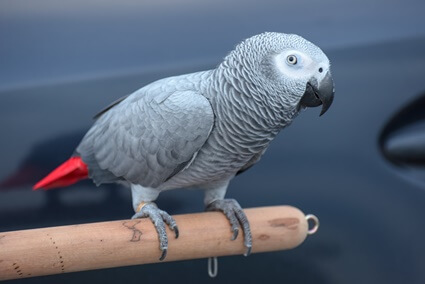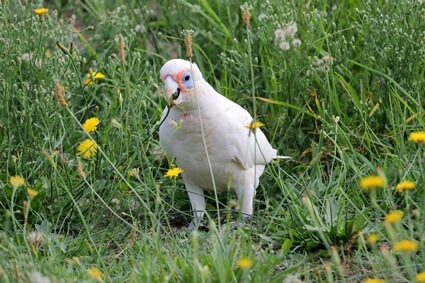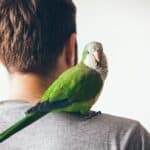Last Updated on April 17, 2024 by Carrie Stephens
Parrots can change the shape and diameter of their pupils with their striated ocular muscles.
Eye pinning is the rapid contraction and dilation of the pupils. The iris expands (mydriasis) and contracts (miosis) based on sensory stimuli.
When eye pinning occurs with the nictating membrane (third eyelid), which sweeps across each eye, parrots can focus attentively on things of interest.
Expect a parrot to narrow its eyes as it focuses on what it doesn’t yet recognize or identify as safe. This enables a parrot to assess the situation and whether it must take evasive action.
A parrot usually pins its eyes involuntarily, often as an emotional response to excitement or annoyance.
Parrot Eye Pinning Meaning
Parrots’ eyes are disproportionately large relative to the rest of their head. Their eyes are also positioned on the sides of their heads, maximizing their field of vision. Parrots can see almost 300 degrees.
Eye pinning is an instinctual response to stimuli, ranging from curiosity to excitement to anger. It’s common in Poicephalus species (Meyer’s, Senegals, etc.), Amazons, macaws, and African grays.
The meaning of eye flashing must be assessed along with their body language and vocalizations.
Excitement
Parrots are highly emotional animals that grow excited about the things they enjoy. This includes:
- Mealtimes and mid-day snacks.
- Playing with their toys.
- Performing clever tricks.
- Leaving the cage to fly and explore.
Once a parrot has bonded with its owner, it’s common for them to show excitement.
According to Behavioral Processes, parrots pin their eyes when reunited with a favorite person (usually someone who meets their care needs) after several hours of separation.
Talking
If you have a talking parrot, it may pins its eyes when it uses words it finds fun to say. It signifies attentiveness, showing that the parrot is engaged in the conversation.
If you’re teaching a parrot new words, this is an opportune time to expand its vocabulary.

Overstimulation
There’s a fine line between excitement and overstimulation. Consistent eye pinning can be a warning. If the parrot is wound up, approaching carries risk because you could get bitten.
Overstimulation shouldn’t be confused with aggression. In the latter case, the parrot is agitated and angry. In these instances, biting will be willful, while overstimulation will be a warning nip.
Overstimulation can be resolved by retreating and giving the parrot a little space. Your pet parrot will soon calm down, as indicated by the eyes returning to their usual size.
Courtship
Pupillary flexion is among the ways male parrots show arousal to females. This will be combined with other actions to impress females, like singing, bowing, dancing, and strutting.
You’ll also observe the male constricting its pupils as it regurgitates food into the female’s beak. Interestingly, pupil flexion doesn’t occur during copulation.

Curiosity
Parrots are curious birds. That said, they’re prone to neophobia (an innate fear of the unfamiliar.)
As explained by Applied Animal Behavior Science, early experiences are connected to managing neophobia. Parrots given new experiences as chicks are less likely to fear them in adulthood.
If the parrot pins its eyes each time something changes in its environment, like changing toys, make the adjustments gradually. Change 1 or 2 toys rather than everything at the same time.
Annoyance
Eye pinning is a non-verbal sign of agitation that should always be heeded.
Parrots can grow distressed when humans or animals (including cagemates) encroach on their territory. Eye-pinning and a hunched-up posture are often used together to ward off others.
Your parrot may be excited to see you but resentful that it has been left alone or is annoyed because you’ve given someone else attention.
Additional posture and vocal cues will warn you if the parrot is pinning its eyes in anger:
- Head dropped and not bobbing.
- Puffing up or feathers close to the body.
- Tail feathers spread and not wagging.
- The wings are slightly away from the body and aren’t flapping.
- Body shaking and swaying.
- Beak slightly open to increase intimidation.
- Unfriendly sounds, like hissing, growling, or screaming.
This suggests that the parrot is annoyed and frustrated, as the eye pinning denotes focus.





